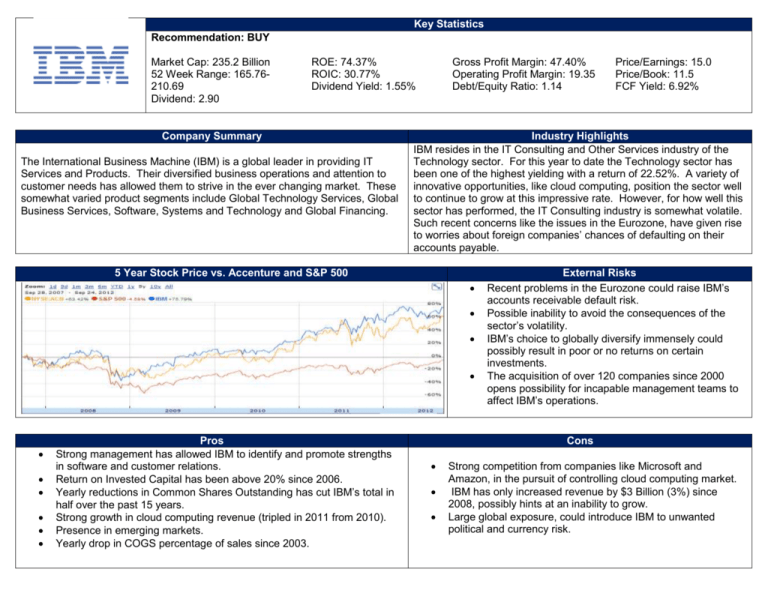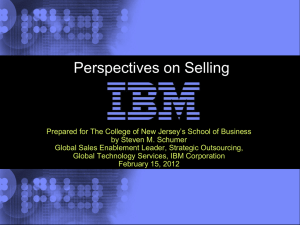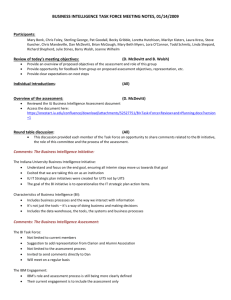IBM Full Report
advertisement

Key Statistics Recommendation: BUY Market Cap: 235.2 Billion 52 Week Range: 165.76210.69 Dividend: 2.90 ROE: 74.37% ROIC: 30.77% Dividend Yield: 1.55% Company Summary The International Business Machine (IBM) is a global leader in providing IT Services and Products. Their diversified business operations and attention to customer needs has allowed them to strive in the ever changing market. These somewhat varied product segments include Global Technology Services, Global Business Services, Software, Systems and Technology and Global Financing. Gross Profit Margin: 47.40% Operating Profit Margin: 19.35 Debt/Equity Ratio: 1.14 Industry Highlights IBM resides in the IT Consulting and Other Services industry of the Technology sector. For this year to date the Technology sector has been one of the highest yielding with a return of 22.52%. A variety of innovative opportunities, like cloud computing, position the sector well to continue to grow at this impressive rate. However, for how well this sector has performed, the IT Consulting industry is somewhat volatile. Such recent concerns like the issues in the Eurozone, have given rise to worries about foreign companies’ chances of defaulting on their accounts payable. 5 Year Stock Price vs. Accenture and S&P 500 Pros Strong management has allowed IBM to identify and promote strengths in software and customer relations. Return on Invested Capital has been above 20% since 2006. Yearly reductions in Common Shares Outstanding has cut IBM’s total in half over the past 15 years. Strong growth in cloud computing revenue (tripled in 2011 from 2010). Presence in emerging markets. Yearly drop in COGS percentage of sales since 2003. Price/Earnings: 15.0 Price/Book: 11.5 FCF Yield: 6.92% External Risks Recent problems in the Eurozone could raise IBM’s accounts receivable default risk. Possible inability to avoid the consequences of the sector’s volatility. IBM’s choice to globally diversify immensely could possibly result in poor or no returns on certain investments. The acquisition of over 120 companies since 2000 opens possibility for incapable management teams to affect IBM’s operations. Cons Strong competition from companies like Microsoft and Amazon, in the pursuit of controlling cloud computing market. IBM has only increased revenue by $3 Billion (3%) since 2008, possibly hints at an inability to grow. Large global exposure, could introduce IBM to unwanted political and currency risk. Who is IBM? The International Business Machines Corporation (IBM) is a global leader in providing Information Technology services and products. From their origin in 1910, they have learned to succeed in the constantly changing technological world by adapting their products to match the growing needs of the expanding industry. This success has been maintained as a result of IBM’s focus on instilling particular values. These values can be defined as a dedication to clients’ success, a passion for innovation and creating trust and responsibility in all relationships. The end result of such values has been IBM’s ability to match their innovative products with the needs of customers to create successful business relationships that allow IBM to help their clients gain more value and efficiency from their operations. Through the success of IBM’s ability to provide customers with valuable products and solutions to business queries, they have expanded their operations into five main sectors: Global Technology Services (GTS), Global Business Services (GBS), Software, Systems and Technology, and Global Financing. The Global Services, GTS and GBS, are concentrated on providing IBM’s renowned information technology and professional solutions to businesses with the goal of creating more efficient and valuable operations. The Software segment allows customers to better integrate systems and improve business results through the use of IBM’s middleware and operating systems. Additionally, Systems and Technology provides clients with extra computing power and storage by providing a variety of servers and storage systems. Finally, Global Financing is primarily fixated on aiding consumers’ acquisition of IBM products. As can be observed, IBM has grown into a technologically diversified corporation. By taking a look at IBM’s operations today, it becomes clear that their focus on providing and creating innovative solutions for the customer is as strong as it has ever been. Their current plan for the future can be summed up nicely by the recent slogan, “Let’s Build a Smart Planet.” In other words, IBM’s strategy for the time being is mostly consumed by the Smarter Planet initiative. The Smarter Planet is a program cantered on providing customers with the ability to not only address problems, but predict and avoid them, thus producing more profitable operations. By expanding cloud computing and business analytics, while further customizing offerings to customer’s specific needs, IBM plans on reshaping the way their clients do business. The consistent change and growth of IBM make them an exciting company to follow as they progress into the future. Business Analysis As an information technology product and service provider the International Business Machine Corporation’s success is highly leveraged on their ability to create solutions that will create value for their customers. Thus, as IBM has developed into a globally successful company they have created a competitive advantage through their customer centric focus. This customer based business model has resulted in IBM’s focus of providing unique solutions to clients designed around increasing revenue and efficiency, while minimizing the costs incurred. In addition to concentrating business functions on the customer, the company is also heavily fixed on maximizing value for shareholders. Through the process of setting goals for the future and expanding operations IBM has created opportunities for growth and risk described below. Growth Opportunities Smarter Planet: It would appear that IBM has made Smarter Planet their leading growth initiative. This effort is concentrated on allowing their customers to absorb the immense amount of data created each day, and use it in efficient ways to anticipate changes in their industry, thus resulting in a competitive advantage. Smarter Planet is primarily led by two other growth platforms, Business Analytics and Cloud Computing. Business Analytics allows one to collect, organize and use the “big data” to make informed decisions. While, Cloud Computing operates with the goal of eliminating unnecessary costs of holding data in specific hardware and programs; in turn, allowing solutions to be created in an easily accessible and efficient manner. The positive results of Smarter Planet have already been seen; as its revenue grew almost 50% from 2010 to 2011; furthermore, the revenues of Cloud Computing more than tripled and Business Analytics’ increased by 16%. And beyond the revenue gains, successful applications of the program have also occurred. For example, police forces have been able to lower crime rates by using data to track patterns and predict when and where problems will occur. The overall valuable nature of the Smarter Planet program should create a global demand for IBM’s solutions and enable the outlook to be positive. Global Expansion: In IBM’s efforts to expand, the company has grown its global outlook. By recognizing that emerging markets are projected to account for more than 60 per cent of the global GDP growth in the upcoming four years, IBM has decided to invest heavily in these markets. This growth program has resulted in IBM growing its presence in over 170 different countries. Furthermore, this action has allowed IBM to focus its outlook beyond the traditional international countries like Brazil, Russia, India or China (BRIC). Instead, IBM has found itself in growth markets, such as various locations across the African continent, to develop talent and bring innovative tools to make these international locations more successful. In total between 2010 and 2011 IBM recognized an 11 per cent increase in revenue for the growth markets, accounting for 22 per cent of total global revenue. Clearly, there is room to grow and IBM plans to capitalize on this opportunity by increasing growth markets revenue to 30% of the total global earnings. Business Segment Alterations: Through IBM’s efforts of growing their operations by creating new opportunities, they also restructured their business segments. For a company like IBM who is heavily exposed to the changing needs of the technological community, they need to alter their business operations to continue their highly customer based focus. IBM has had a successful track record of tackling such problems through the divestment of certain businesses. For example, in 2005 the company sold of its PC division in light of more valuable opportunities. This restructuring process has found IBM currently expanding their more profitable and value gaining businesses. Such expansions include IBM’s goal to make 50 per cent of their profit come from their high gross margin sector software. In 2011 alone, IBM saw its software sector earn $25 billion in revenue at an 88.5% gross margin. Expansion choices like these show IBM’s ability to recognize where their strengths lie and plan for the future. With such growth opportunities at hand IBM has been able to produce an EPS prediction of $14.29 for 2012, and set a financial road map with the goal of creating earnings per share of $20 by 2015 (See Graph on Right). Risks Global Exposure: IBM’s growth initiative to expand globally may increase their risk exposure. By globally growing, IBM has naturally expanded into the Eurozone. The recent economic turmoil of Europe raises questions about the stability of IBM’s revenue recognition from such partnerships. For instance, the highly annuity based aspect of IBM’s software segment will be exposed to higher default risk caused by the economic problems. Additionally, one may assume that overall demand for their products may decline as foreign companies’ budgets shrink. And finally, as was seen in a $1 billion decline in the third quarter of 2012, global investment exposes IBM to currency risk. In total, the unstable nature of some economic environments raises issues about the short-term global growth of IBM. Cloud Security: With the Smarter Planet initiative set to grow IBM’s value by helping companies become more efficient, there are some risks to be addressed. Primarily, one needs to look at the security risk of the ever growing cloud computing market. As more and more data is produced and added to the cloud, IBM will expose themselves to more risk of data corruption, leaks or infiltration. Consequently, IBM will need to expand their expenses to increase the security of this function to lower their liability. Acquisition Problems: A growth initiative of IBM not described in depth above is their immense growth through acquisition approach. Since, 2000 IBM has acquired over 120 companies, thus increasing exposure to risks of integrating external operations into the IBM team. In 2011, the company acquired five companies for almost $2 billion. With each acquisition, IBM increases their exposure to the risk that the companies will fail to meet operational goals or ability to align with the customer centric and innovative mind set of IBM. Industry Analysis The outlook for IBM’s IT consulting industry, subsidiary of the technology sector, appears to be neutral to slightly positive. For the year to date, the technology sector as a whole has made up for 19 per cent of the S&P 500 and grown 7.7 per cent. With this slightly positive outlook there is room for growth; however these opportunities are also associated with an assortment of risks and negative aspects to the industry. Primarily, the ability for IT consulting companies to be successful hinges on the status of the domestic and global economies. The uncertain outlook of the European economy has not boded well for IT spending, as it is anticipated that overall spending will only increase by 3.8% annually. Yet with this low growth outlook for spending, it appears there are steps companies can take to possibly hedge against this risk. With the projections for minimal spending, companies in the IT consulting industry are pursuing a variety of actions to extend their growth potential. One such action is acquiring or partnering with other companies. With the volatile nature of the market, valuable smaller companies may be for sale. Yet as was discussed before the process of growing through acquisitions does pose some threats. In addition to acquisitions, there appears to be a trend in creating shorter IT contracts in order to decrease costs and increase the short-term return on investment. Finally, in the pursuit of growth, companies are similarly to IBM pursuing expansion into developing economies. The opportunities presented by growth markets do present opportunities to make international companies more efficient, but do present risk. By increasing exposure to developing countries, IT consulting companies will need to spend more time evaluating political, currency and other risks often associated with foreign investment. As one can notice, IT companies need to be cautious in their pursuit of creating extra value. Valuation Based on our valuation of IBM’s growth prospects, risks and the current standing of the industry, the company appears to undervalue. A discounted cash flow model shows that IBM has an intrinsic value of $322.81 (See Appendix for Calculation Details). This high valuation can be backed by the overall strength of the company and investment. Aside from the immense growth opportunities being explored by IBM, the company presents an investor with a free cash flow (entry) yield of 7.5%. The growth of IBM’s free cash flow was equated to roughly equal 6% (See Appendix). This growth was determined with the help of a variety of financial factors. Such measures were the 2011 return on equity (73%) of the amount of money IBM retained after accounting for financing activities, like stock repurchase and dividends paid (plowback ratio). Another measure recognized was the return on equity of the capital expenditures invested back into the company after depreciation. IBM’s weighted average cost of capital (discount rate) was calculated to equal 9.4%. This measure was calculated using a cost of equity determined by the use of the CAPM model where the risk free rate was adjusted due to the low nature of interest rates today. The terminal value of IBM was determined to equal 5%, as a result of the consistently strong performance of the company. Appendix Growth Rate: Discounted Free Cash Flow





